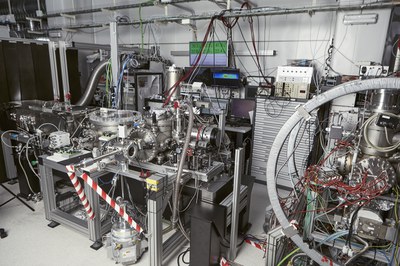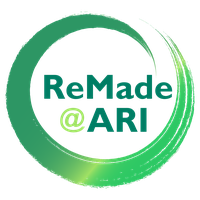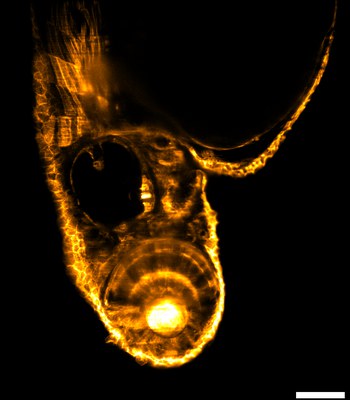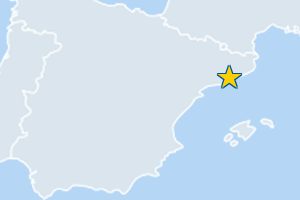ICFO (Barcelona, Spain)
Phys. Rev. X. 11, 041060 (2021)Research highlights
Attoscience and Ultrafast Optics
Investigation of the real-time dynamics of electrons and nuclei in atoms, molecules and solids to determine the underlying multi-body physics and correlations. This research addresses questions of fundamental and applied nature, ranging from chemical isomerization to phase transitions and energy harvesting [Nature Phot. 15, 277-280 (2021), Nature Comm. 12, 1520 (2021), Phys. Rev. X. 11, 041060 (2021), Ultrafast Science 3, 4, (2023)].
Cellular and Molecular Biology
Optimizing new molecular tools for high resolution detection of cellular events regulated by ubiquitin family members. In LSFM, images are generated through a plane-based strategy in which only a single slice of the sample is excited per exposure time, and the emitted photons are collected perpendicularly, forming an image. In our implementation in which the sample can be imaged either as in any classical configuration, as it flows through the light-sheet using a fluidic approach, or a combination of both. We also evaluate its ability to image a variety of samples, from zebrafish embryos and larvae to 3D complex cell cultures [Sci. Rep. 12, 1969 (2022)].
SLN Facility
At the Superresolution Light microscopy and Nanoscopy (SLN) facility, we analyse network functional alterations after a focal lesion in neuronal tissue by combining laser microsurgery and calcium fluorescence imaging. We show that the network actively participate in recovery, restoring the initial network activity. Our approach offers new insights for modelling network functional loss and recovery with applications that go from stroke to degenerative disorders. [eNeuro 7, 1-13 (2020)]
A major challenge is the generation of reproducible neural networks together with the ability to interrogate and record at the single cell level. In this study, we report on the use of 2PP scaffolds with tailored topographies as an effective method of producing defined in vitro human neural networks for application in influencing neurite guidance and complex network activity. [Lab on a Chip 20, 1792-1806 (2020)]
Projects performed by external users >>
Expertise
 ICFO
ICFO
Attoscience, laser research, nonlinear optics, extreme photonics, x-ray spectroscopy, electron diffraction, material research, 2D and quantum materials, microscopy, biological and medical research.
Attoscience and Ultrafast Optics
The aim of our research is the development of tools and establishment of methodologies for investigation of the ultrafast events that are caused by electrons inside atoms, molecules, solids and biological matter. The power of attoscience and ultrafast optics lies in the incredible time resolution that gives access to observing the triggering events that are caused by electronic rearrangement and ultimately lead, at hugely varying temporal scales, to molecular dissociation, chemical reactions, excitonic energy transfer or even biological function. Our research is diverse and includes pioneering development of new sources of high power and intense few-cycle pulses and frequency combs at long wavelengths up to the long wave infrared regime. These sources are key enablers for coherent soft-X-ray generation across the water window (300-500 eV) and attosecond emission below the atomic unit of time (24 as). These sources enable element selective and time resolved measurements, lensless imaging as well as using electron recollision to image bond distances in molecules.
SLN
We conduct research and development at the cutting-edge of several microscopy and super resolution imaging techniques. We combine different technologies to make them compatible in a multimodal imaging fashion. Research activities include beam engineering, wavefront control and integration of novel light sources with different beam or pulse parameters. We study novel (endogenous and exogenous) contrast agents to be applied to a wide variety of biomedical samples and imaging regimes. We also design novel algorithms for image quantification and analysis. Finally, our research involves optical manipulation tools such as Optical Tweezers and Femtosecond nanosurgery.
Expertise in recyclable materials
 We have developed solar cell technology based on abundant and non-toxic nanostructured materials, such as organic polymers and quantum dots. This innovation not only provides green electricity but also boasts attractive features like transparency, flexibility, color tunability, and cost-efficiency. Additionally, we are actively exploring thermo-photovoltaic systems to harvest waste heat.
We have developed solar cell technology based on abundant and non-toxic nanostructured materials, such as organic polymers and quantum dots. This innovation not only provides green electricity but also boasts attractive features like transparency, flexibility, color tunability, and cost-efficiency. Additionally, we are actively exploring thermo-photovoltaic systems to harvest waste heat.
Moreover, solar energy plays a crucial role in powering both the production and storage of sustainable energy carriers, including hydrogen generated through water electrolysis and solar fuels produced from CO2 capture. To achieve this, our researchers employ catalyst-driven electrochemical or photo-electrochemical processes inspired by photosynthesis.
>> Watch the Laserlab-Europe Talk on 'Time-resolving energy dissipation pathways in materials'
Services for industry
Lasers
Laser development - Development of a new platform for mid IR light sources, development of a platform for x-ray generation
Prototyping - Consulting and prototyping a lser systemto be used for textile and fashion industry
Medical and pharmaceutical/Agriculture and food/Cultural and Natural Heritage: Archeology and Arts
Microscopy - Expertise in light microscopy imaging, including super resolution (STORM/STED), confocal, multiphoton, Raman and light sheet imaging
Search for other industry services>>
Equipment offered to external users
 ICFO
ICFO
- Attoscience facility
- UV to mid-IR laser sources
- Attosecond SXR beamline
- Reaction Micorscope, Single-Molecule Electron Diffraction
- Strong field HHG in solids and spectroscopy
- Etching: ICP, RIE and wNanofabrication lab
- Lithography: electron-beam and optical lithography
- Focused Ion Beam: Ga/e- and He/Ne dual-beam tools
- Etching: ICP, RIE and wet etching
- Thin film deposition: thermal and electron-beam evaporation, sputtering, atomic layer deposition
- Surface preparation: plasma asher, UVO cleaner, ovens
- Characterization: SEM, EDX, atomic force microscopy, spectroscopic ellipsometry, profilometry, microscopy, etc.
- Specific controlled environment: glove boxes, fume hoods, laminar flows, etc.
- Super-resolution Light Microscopy & Nanoscopy Facility
- Advanced Engineering Lab
- Biology Lab
- Molecular Biology: Molecular cloning. Gene expression. PCR. Electrophoresis. Genome editing using CRSPR/Cas9 technology.
- Biochemistry: Protein purification. PAGE. Western blot. Elisa.
- Mammalian cells: Routine cell culture and sample preparation. Transient transfection. Generation of stably transfected cell lines. Cryopreservation.
- Immunoassays: Antibody conjugation. Immunosfluorescence. Immunoprecipitation.
- Microorganisms: Routine culture. Maintenance and update of a bacterial strain collection. Plasmid propagation and purification.
- Culture of wild type and different mutants of invertebrate model organism Caenorhabditis elegans.
- Biological sample handling and preparation for STORM and other super resolution microscopy techniques.
SLN
- A STED microscope, 3 colour, 3D, gated.
- STED CW microscope, operating also as a multiphoton (TPEF, SHG).
- A multimodal confocal microscope operating also as a multiphoton (TPEF, SHG, PSHG, THG). The system can be coupled to different ultrashort pulsed lasers working at the central wavelength of 800-900nm, 960nm, 1040-1060nm, 1500nm.
- A custom made multiphoton microscope system (TPEF, SHG, PSHG, THG).
- Custom made Light Sheet Microscopes (3):
- high throughput combined with fluidics, multiview.
- Fast volumetric imaging, with different resolutions (low and high NA), using electrically tunabe lenses or wavefront coding
- Ultramicroscope for clarified samples
- A Raman microscope and expertise in statistical analysis of biological samples.
- A custom made Adaptive Optics based Scanning Laser Ophthalmoscope with retinal tracker

A 2dpf zebrafish larvae is imaged using a LSFM setup developed at ICFO, at the
Super-resolution Light microscopy and Nanoscopy (SLN) facility with a double illumination scheme. (Scale bar 100 um)


